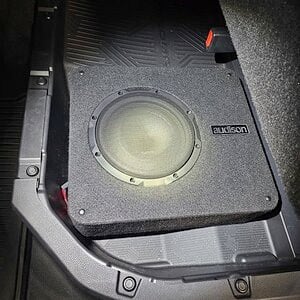You are using an out of date browser. It may not display this or other websites correctly.
You should upgrade or use an alternative browser.
You should upgrade or use an alternative browser.
-
19Participant count
-
Participant list
bubbagumper6 5,000+ posts
CarAudio.com Veteran
Gain is to match the input voltage level ONLY. There's many different sources out there (different HU's, etc) and they all have different 'pre-out' voltages (2V, 4V, 6V, 8V, etc). With these different input voltages if the amplifier just linearly amplified the signal then you would get more power with a higher input voltage (not ideal). So the gain knob is used to compensate and adjust the amplifier to produce it's rated power level based on the input voltage. Thus, usually the higher input voltage you have, the LOWER the gain knob will need to be.
If you want, you can think of the gain as a multiplier. If the amp is rated for 1000watts and your input voltage is 2V you'll need a multiplier of 500, but if you have an input voltage of 8V you would only need a multiplier value of 125 (thus a lower gain level).
However this DOES NOT mean that you can just turn the gain knob up to get more output, once you reach your amp's rated power output anything higher will result in a clipped output which is undesirable to say the least.
If you want, you can think of the gain as a multiplier. If the amp is rated for 1000watts and your input voltage is 2V you'll need a multiplier of 500, but if you have an input voltage of 8V you would only need a multiplier value of 125 (thus a lower gain level).
However this DOES NOT mean that you can just turn the gain knob up to get more output, once you reach your amp's rated power output anything higher will result in a clipped output which is undesirable to say the least.
Flex68 10+ year member
dilligaf
What both recent posters said is correct: If you have subs that can handle max output of your amp, then you set your amp's output voltage with a DMM after inputting the amp's max rated power into the formula outlined on the sticky (and several places in this thread);
if your subs have a LOWER rated WRMS than the max output of your amp, then you calculate using the sub's max WRMS rating, which is referred to as gaining-down your amp.
Ex 1.) Sub has rating of 1000WRMS while amp will only output max of 760WRMS into 4 ohms. Via the formula, sqrt(760*4) = 55.1, so you'd set the amp to output 55.1V.
Ex 2.) Same amp, same sub impedance, but this sub can only handle 500WRMS. sqrt(500*4)=44.7V. (So you are maxing your driver, but gaining-down your amp to do so)
Colossus: I didn't check to see if the OPTI is rated for running at 1/2 ohm, but just via the formula, sqrt(3200*0.5) = 40V.
However, 3200WRMS is quite a bit of power...hope ur subs and system's electrical are ready for it
if your subs have a LOWER rated WRMS than the max output of your amp, then you calculate using the sub's max WRMS rating, which is referred to as gaining-down your amp.
Ex 1.) Sub has rating of 1000WRMS while amp will only output max of 760WRMS into 4 ohms. Via the formula, sqrt(760*4) = 55.1, so you'd set the amp to output 55.1V.
Ex 2.) Same amp, same sub impedance, but this sub can only handle 500WRMS. sqrt(500*4)=44.7V. (So you are maxing your driver, but gaining-down your amp to do so)
Colossus: I didn't check to see if the OPTI is rated for running at 1/2 ohm, but just via the formula, sqrt(3200*0.5) = 40V.
However, 3200WRMS is quite a bit of power...hope ur subs and system's electrical are ready for it
chillin 10+ year member
CarAudio.com Elite
You and dooski are both right. If you have a amp that puts out much more than your speaker can take, set your gains according to speaker rms. If you have a sub such as the skar vvx which everyone says can take way more power than rated, and your amp puts out 1000w, set it for 1000 and hope the sub can handle it. Or if you bought your amp because it matches your sub in terms of rms (which many do) you could set it to the amp or sub
---------- Post added at 01:20 PM ---------- Previous post was at 01:19 PM ----------
Flex beat me to it
---------- Post added at 01:20 PM ---------- Previous post was at 01:19 PM ----------
Flex beat me to it
southpoleman69 10+ year member
CarAudio.com Elite
I'm setting my rubicon at 40 volts to match a lvl 4. 1600x1@1, and lvl 4 is rated at 1400. If I set accordin. To sub its like 37.6, if I se according to amp its 40. So I'm basically ok either route I go?
Patthehat033 10+ year member
Senior VIP Member
You want to set the gain with the DMM based on the *RMS* output of the amplifier. If you decide to set the gain based on your maximum output, you will most likely never hit that or fry your amplifier. Most lower quality amplifiers have a much higher "maximum" out put rating than rms rating. The maximum output will only occur when your head unit or receiver sends out a signal for a large bass note. Some higher quality amplifier's like Rockford, will tell you that they put out say 500 watts and will in reality put out about 1000wrms.
So basically make sure you set your amplifier based on its rms output. BUT also make sure you set your amplifier according to your subwoofer rating. If your subwoofer can handle 500rms and your amp can put out 600rms. Make sure you set your amplifier at 500rms not 600rms, or you will eventually fry it depending on the subwoofer, some are very under rated.
You can either have the sub woofer hooked or unhooked. If you doing it while the subwoofer is unhooked, when you hook it back up make sure the voltage is near your desired voltage or do it again. Good luck.
So basically make sure you set your amplifier based on its rms output. BUT also make sure you set your amplifier according to your subwoofer rating. If your subwoofer can handle 500rms and your amp can put out 600rms. Make sure you set your amplifier at 500rms not 600rms, or you will eventually fry it depending on the subwoofer, some are very under rated.
You can either have the sub woofer hooked or unhooked. If you doing it while the subwoofer is unhooked, when you hook it back up make sure the voltage is near your desired voltage or do it again. Good luck.
southpoleman69 10+ year member
CarAudio.com Elite
Well how are you to know the rms as oppose to max output of the amp. Nowhere have I found the rms of the 1600.1 rubicon. Just 1600x1@1. I would rather set it to the rms, if I knew it
MisterDeadeye 10+ year member
Bannned
Probably from here: Soundstream - Rubicon AmplifiersWell how are you to know the rms as oppose to max output of the amp. Nowhere have I found the rms of the 1600.1 rubicon. Just 1600x1@1. I would rather set it to the rms, if I knew it
1600 IS the RMS.
Patthehat033 10+ year member
Senior VIP Member
southpoleman69 10+ year member
CarAudio.com Elite
southpoleman69 10+ year member
CarAudio.com Elite
So then setting my gains at 40 volts is ideal, since the amps rms is 1600, with my sub at 1 ohm, is 40 volts.
Patthehat033 10+ year member
Senior VIP Member
What about amps that are under or over rated? i would assume i need to somehow check what the real ouput is somehow but not all brands list the actual ouput at any given voltage.
I got a JL 600/1 amp and i seriously doubt it puts out exactly 600 watts in 2ohms so i always wondered how setting the gain using a DMM could be very accurate or how to know if the DMM is even accurate. i read that not all of them are.
I got a JL 600/1 amp and i seriously doubt it puts out exactly 600 watts in 2ohms so i always wondered how setting the gain using a DMM could be very accurate or how to know if the DMM is even accurate. i read that not all of them are.
Patthehat033 10+ year member
Senior VIP Member
It doesn't affect how you check it if it is under rated, that just means the amp has the ability to put out a greater output. The equation will be the same either way, so you will still look for the same voltage. If it's under rated, the amp might not be able to hit that voltage at all or without clipping the signal.
southpoleman69 10+ year member
CarAudio.com Elite
In whic case the equation doesn't work accurately then. This is what confuses meIt doesn't affect how you check it if it is under rated, that just means the amp has the ability to put out a greater output. The equation will be the same either way, so you will still look for the same voltage. If it's under rated, the amp might not be able to hit that voltage at all or without clipping the signal.
Activity
No one is currently typing a reply...
Similar threads
Run that bish at .5
- Started by ThxOne
- Amplifiers 2 3
- 31
- 3K
Yes you can set the gain to whatever watt RMS you want below the amps max output using that formula.
- Started by Original wis
- Wiring, Electrical & Installation
- 5
- 1K
To make it easier... use a 40hz (-10db) tone. Set the amp gain to 28.28v.
- Started by ccwatson160
- Wiring, Electrical & Installation
- 5
- 1K
- 4
- 2K
Thank you I did that. It sounds great! Thanks for the advice.
- Started by venturac
- General Car Audio
- 4
- 1K


